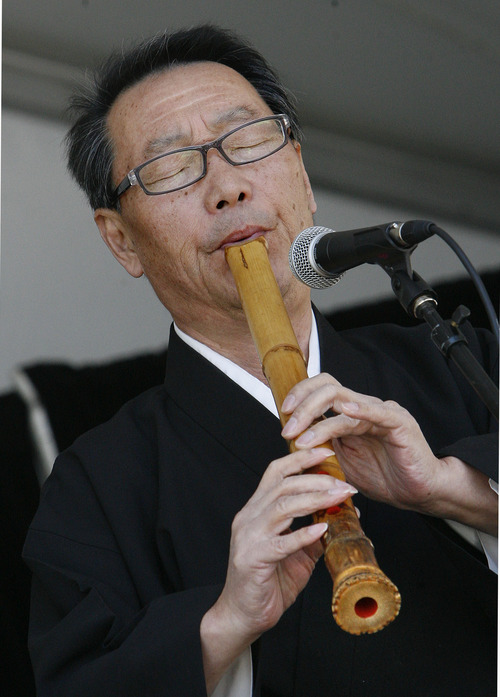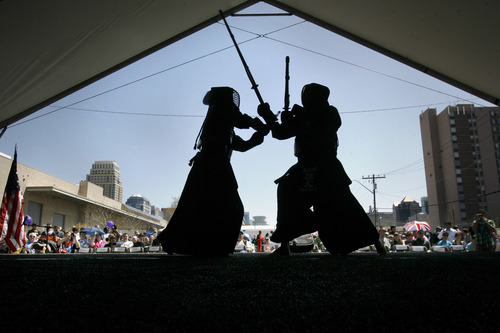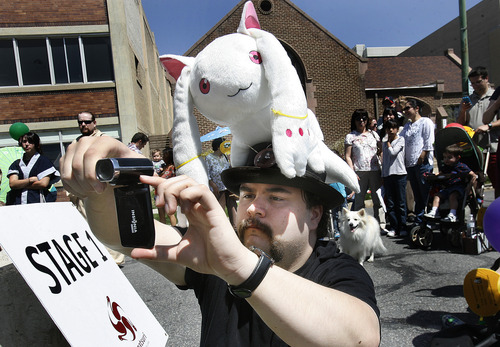This is an archived article that was published on sltrib.com in 2013, and information in the article may be outdated. It is provided only for personal research purposes and may not be reprinted.
Marion Hori was just a baby when her family was sent to an internment camp for Americans of Japanese descent in Arkansas.
She recalls little about it, save waiting in line for food and the persistent mud. But she vividly remembers what her parents told her as a child.
"There was a lot of discrimination," said Hori, whose family settled in Farmington after World War II. "Everyone looked down on us. My parents tried to build into us not to let them do that to us, to be strong. Be proud that you're Japanese."
That pride was on colorful display Saturday for the thousands of Utahns who filled the short block behind the Salt Palace Convention Center for the annual Nihon Matsuri Japan Festival, organized by a committee chaired by Hori.
They gathered in a spot historically known as Japantown, which served as a center of Utah's Japanese community starting in the early 1900s. Construction of the Salt Palace displaced many of the Japanese residents and businesses there in the 1960s. But the Japanese Church of Christ and the Salt Lake Buddhist Temple still flank the area, and each year the festival attracts people of all races from across Utah for performances, food and shopping.
On Saturday, sunny skies and warm weather drew many to the festival to celebrate Japanese culture — both traditional and modern.
In one booth, a vendor sold large, slinky koi fish, while in another visitors played with plush, imported toys. Some festival-goers waited in line for gyoza and sushi, while others snacked on shaved ice and hot dogs.
Perhaps most strikingly, members of Utah's Japanese community — many, like Hori, old enough to remember internment camps — shared the street with countless teenagers and young adults decked out as their favorite characters from Japanese anime cartoons. Some vendors sold anime paraphernalia, and one darkened booth was reserved for anime viewings.
"That has become a part of modern Japanese culture," said Steve Fukushima, a member of the organizing committee. "I think, like anything else, you embrace the old with the new."
At one booth, Stephanie Stork handed out fliers advertising the annual Anime Banzai conference in Layton. As she talked with festivalgoers she wore a white skirt and turquoise blue midriff top with flowing white sleeves, imitating a character from a 1980s anime series.
"As I was a kid in the 1980s, I loved the art style," said Stork, of Brigham City.
Farther down the street, dancers and musicians performed more traditional scenes onstage. The festival began Saturday morning with a taiko drum performance by the Japanese Church of Christ Kenshin Taiko group.
About 20 performers rhythmically hit large taiko drums — made of oak wine barrels and cow hide — as they moved to the beat. Group member Laura Olson, of Salt Lake City, said the Japanese have been using taiko drums for thousands of years.
"Taiko is not just about the sound," said group member Ron Boisvert, of Riverdale, who said he first learned to play while stationed in Japan with the Air Force. "It's about the form, the choreography of it. It transmits the energy of the drummer to the audience."
Kitty-corner from the drums, Ken Yamane, of Sandy, sold bonsai trees. Though Yamane, 68, was born in a California internment camp, he later went on to serve in the Air Force and was stationed in Japan. There he learned the art of growing the miniature trees, he said.
Yamane said he's been going to the festival since its inception.
"It's important to our community," he said. "Every generation loses a little bit of culture, so this is bringing young people out to learn more."
lschencker@sltrib.comTwitter: @lschencker









